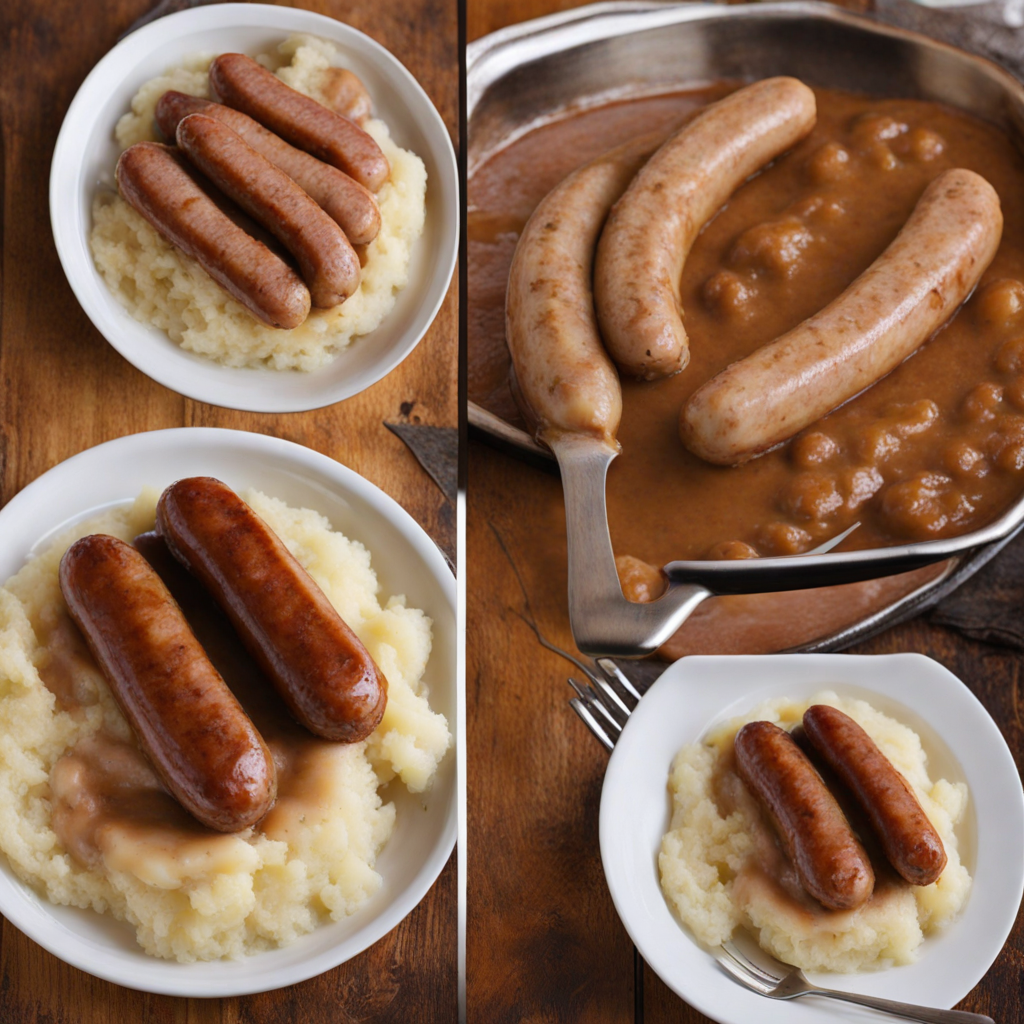Full English Breakfast
The Full English Breakfast is a hearty and traditional meal that embodies the essence of British cuisine. At its core, this feast typically features a combination of crispy bacon, succulent sausages, and perfectly fried eggs. The bacon is often back bacon, providing a delightful balance of flavor and texture, while the sausages can vary from pork to more artisanal varieties, each bringing its unique taste to the plate. This protein-packed beginning is usually accompanied by baked beans, which add a touch of sweetness and creaminess, and grilled tomatoes that provide a refreshing burst of acidity to counterbalance the richness of the meats. To further elevate this breakfast experience, you might find black pudding—a type of blood sausage that offers a rich, earthy flavor and a slightly crumbly texture. Hash browns or fried bread are common additions, giving a satisfying crunch and further indulgence to the dish. The meal is often enjoyed with a robust cup of tea or coffee, making it not just a feast for the stomach but also a comforting ritual to start the day. Each component of the Full English Breakfast plays a role in creating an overall sense of satisfaction and warmth, making it a cherished part of British culture. While variations exist depending on the region or personal preferences, the Full English Breakfast remains a symbol of abundance and comfort. It is often enjoyed leisurely on weekends or special occasions, inviting diners to savor each bite and appreciate the symphony of flavors and textures. The combination of savory meats, creamy beans, and fresh vegetables creates a delightful interplay that is hard to resist, making it a must-try for anyone eager to explore the culinary traditions of the United Kingdom.
How It Became This Dish
The Full English Breakfast: A Hearty Tradition of the United Kingdom The Full English Breakfast, often simply referred to as a “fry-up,” is a culinary staple that embodies the rich history and culture of the United Kingdom. This substantial meal typically includes a variety of items such as eggs, sausages, bacon, baked beans, grilled tomatoes, mushrooms, and toast or fried bread. Its origins, cultural significance, and evolution over time provide a fascinating glimpse into British society and its relationship with food. #### Origins and Historical Context The roots of the Full English Breakfast can be traced back to the 13th century in England, where the concept of a hearty morning meal began to emerge. During this period, the upper classes would enjoy lavish breakfasts, often featuring a range of meats and bread. The term “breakfast” itself originates from the idea of “breaking the fast” after a night of sleep, and it was not uncommon for the wealthy to partake in a substantial meal to fuel their long days. The 19th century marked a significant turning point in the development of the Full English Breakfast. The Industrial Revolution brought about major societal changes, including urbanization and a burgeoning working class that required substantial nourishment to support their labor-intensive jobs. As a result, the idea of a hearty breakfast became more widespread, transcending social classes. The meal became a practical solution for workers who needed energy for their demanding jobs, thus gaining popularity across the nation. #### Cultural Significance The Full English Breakfast is more than just a meal; it represents a cultural phenomenon that reflects the values and lifestyle of the British people. It is often associated with comfort, tradition, and the idea of “the good life.” The breakfast has become a symbol of British hospitality, often served in homes and cafes as a welcoming gesture to guests. In the realm of British cuisine, the Full English Breakfast stands out as a meal that celebrates local ingredients. Each component of the breakfast has its own story and significance. For instance, the sausages, often referred to as “bangers,” have a history dating back to medieval times when they were made from a mixture of meats and spices. The use of baked beans originated from the influence of American cuisine, especially after the British were introduced to them during the colonial period. Tomatoes and mushrooms, both staples of English gardens, highlight the importance of fresh produce in British cooking. Moreover, the Full English Breakfast is often linked to the British concept of “brunch,” a social meal that combines breakfast and lunch. This cultural adaptation has allowed the Full English to evolve beyond its traditional morning time slot, becoming a popular choice for leisurely weekend meals and social gatherings. #### Evolution Over Time As British society evolved through the 20th century, so too did the Full English Breakfast. Post-World War II Britain saw significant changes in food production and consumption. The introduction of convenience foods and changing dietary preferences began to impact traditional meals. While the Full English remained popular, its components gradually shifted to accommodate modern tastes and lifestyles. In the late 20th century, the Full English Breakfast faced challenges from health-conscious trends that emerged during the rise of the “low-fat” movement. Many began to view the traditional breakfast, often high in fats and calories, as unhealthy. As a result, alternatives emerged, such as the “healthy breakfast,” which replaced fried foods with poached eggs, whole grains, and fresh fruit. This shift led to a diversification of breakfast options in cafes and restaurants, allowing for a broader interpretation of what a “traditional” breakfast could be. Despite these changes, the Full English has managed to retain its iconic status. In the 21st century, the breakfast has experienced a resurgence in popularity, thanks in part to the rise of the “foodie” culture. The Full English has been embraced by a new generation of chefs and food enthusiasts who celebrate its heritage while experimenting with modern twists. Gourmet interpretations of the classic breakfast have appeared, utilizing artisanal ingredients and innovative cooking techniques. #### Modern Interpretations and Global Influence Today, the Full English Breakfast can be found not only in traditional pubs and cafes across the UK but also in various forms around the world. With the globalization of food culture, international variations of the Full English have emerged, adapting to local tastes and ingredients. For example, in Australia and New Zealand, a variation known as the “Big Breakfast” has become popular, incorporating local produce and flavors while maintaining the essence of the original. The Full English Breakfast has also made its way into popular culture, often depicted in British films and television shows as a quintessential element of British life. It is frequently featured in travel literature, enticing visitors to experience an authentic British morning. The breakfast has become a rite of passage for tourists and expatriates alike, who seek to indulge in this hearty meal as part of their cultural exploration. #### Conclusion The Full English Breakfast is more than just a meal; it is a reflection of British history, culture, and identity. Its evolution from a hearty meal for the upper classes to a beloved staple enjoyed by all classes of society speaks to the adaptability and resilience of British culinary traditions. As it continues to evolve in response to changing tastes and lifestyles, the Full English Breakfast remains a cherished symbol of comfort and community, embodying the spirit of the United Kingdom. Whether enjoyed at home or in a bustling café, this iconic breakfast will always hold a special place in the hearts and stomachs of those who partake in it.
You may like
Discover local flavors from United Kingdom







